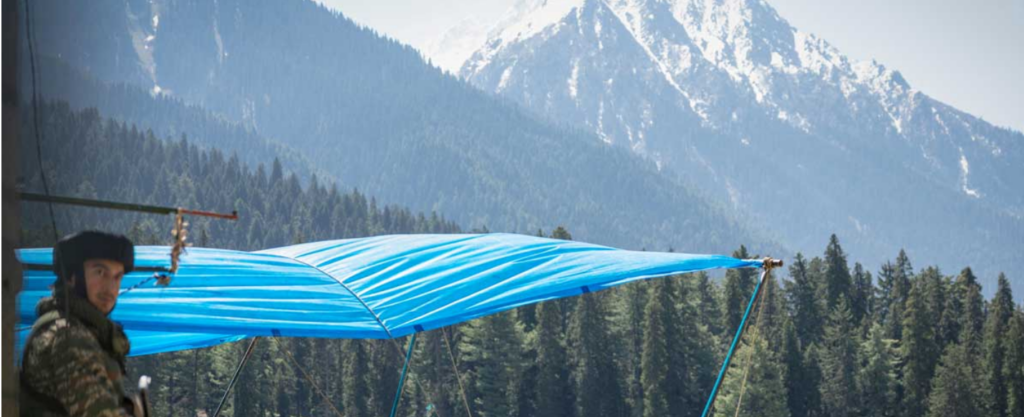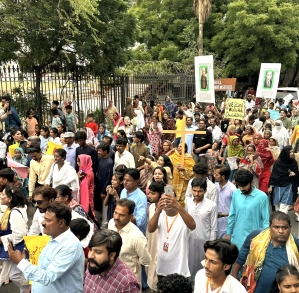
On the afternoon of 22 April, militants mercilessly gunned down 26 civilians and wounded more than two dozen in Pahalgam, a well-known tourist destination in the Indian-administered region of Kashmir. While the area has long been plagued by a separatist insurgency, this latest attack caused the highest number of civilian casualties in over twenty years. The militants entered the Baisaran meadow, a scenic picnic spot accessible only on foot or by pony, from the surrounding forest, and proceeded to single out non-Muslim men before executing them at point-blank range. With one exception – an area resident who tried to intervene – the victims were all tourists, many accompanied by their families.
Video footage of the dead bodies and traumatised family members aired on TV channels and social media platforms, sparking a nationwide furore. Virulent condemnation of both Kashmiris and Muslims was heard across India, where over 80 per cent of the population is Hindu. Many Indians demanded retribution against Pakistan, which has long supported militancy in the disputed territory of Jammu and Kashmir. Criticism of the Indian government’s perceived failure to protect civilians was also widespread. Hundreds of tourists were visiting Baisaran at the time of the attack, and the nearest army camp is only 1km away, but the government had not deployed enough security personnel to guard the meadow. The fact that Indian Home Minister Amit Shah had visited Jammu and Kashmir as recently as early April, and declared “the entire terror ecosystem” in the region to have been “crippled”, only exacerbated the perception that Prime Minister Narendra Modi’s Hindu nationalist government had been caught flat-footed.
What have been the reactions to the attack?
Kashmiris are in shock and alarmed at the prospect of a backlash. Locals organised a candlelight vigil on the evening of the massacre, and Kashmiri leaders from across the political spectrum – from anti-India separatists to pro-India politicians – have condemned the attack, calling for a bandh, or general shutdown, of the entire Kashmir Valley. This measure has traditionally been deployed as a protest in the Muslim-majority region, but usually to denounce actions by the Indian government, rather than by militants. “I’m shocked beyond belief”, the chief minister of Jammu and Kashmir, Omar Abdullah, said in a post on X. “This attack on our visitors is an abomination. The perpetrators of this attack are animals, inhuman [and] worthy of contempt. No words of condemnation are enough”.
Prime Minister Modi cut short a visit to Saudi Arabia to head back to New Delhi, where he immediately held an emergency cabinet meeting. Home Minister Shah flew to Kashmir to pay homage to the victims, meet their grieving families and visit the site of the massacre. “India will identify, track and punish every terrorist and their backers. We will pursue them to the ends of the earth”, Prime Minister Modi declaimed. “Terrorism will not go unpunished. The time has come to raze whatever is left of the terror haven”.
Though Modi did not name Pakistan, his warning could be understood as a veiled threat against Islamabad. Militants have been leading an anti-India insurgency in Jammu and Kashmir since 1989, which India claims is in fact terrorism sponsored by Pakistan. Islamabad rejects the charge, while asserting that it fully supports the Kashmiri right to self-determination. The first indication that India would blame its neighbour for the Pahalgam attack came from Indian Defence Minister Rajnath Singh. “[We] will not only trace those who perpetrated this incident. We will also reach out to those who, sitting behind the scenes, have conspired to carry out the nefarious act on the soil of India”, he said. Soon thereafter, the Indian government announced it was suspending the Indus Waters Treaty, a decades-old mechanism for sharing the waters of the Indus River between India and Pakistan. The government also closed the only border crossing between the two countries, expelled a number of Pakistani diplomats and scaled back its own diplomatic representation in Islamabad.
Pakistan, for its part, issued a statement expressing condolences for the victims’ families, but stopped short of condemning the attack. In a TV interview, Pakistan Defence Minister Khawaja Muhammad Asif denied that his government had any connection to the massacre, arguing that it was the result of homegrown resistance to New Delhi’s policies in Jammu and Kashmir.
The attack’s timing was also significant, as it occurred during a visit to India by U.S. Vice President JD Vance. His presence in India at the time guaranteed that the killings would receive global attention. Both U.S. President Donald Trump and Vance spoke with Modi to offer their condolences, while condemnations of the attack and statements of support for the Indian government poured in from around the world.
Who was behind the attack?
A militant group known as The Resistance Front (TRF) has claimed responsibility for the attack. The group said the victims were not tourists but members of various security agencies on a trip organised by the Indian government. While a couple of the victims have been identified as members of security bodies, there is no evidence to support this assertion. Indeed, TRF has regularly made claims that its targets were affiliated with the government, but without providing any evidence.
Indian security forces regard TRF as a proxy of the Pakistan-based Lashkar-e-Tayyaba, which for decades was one of the active militant organisations in Kashmir fighting to overthrow Indian rule but has gone largely silent in recent years. Along with a few other outfits, it re-emerged in 2019, shortly after New Delhi unilaterally revoked Jammu and Kashmir’s semi-autonomous status, which had been established in 1952, and downgraded the region to a union territory ruled directly by the federal government. Since then, New Delhi has pushed through legislation and administrative reforms that have done away with constitutional safeguards reserving land and government jobs for locals. As Crisis Group reported in 2022, resentment has festered among Kashmiri Muslims, who see these reforms as an attempt to alter the demographics of the only Muslim-majority region in the country. Anger and anxiety about Indians coming in from other parts of the country and changing the region’s identity has, in turn, given a boost to militancy in the region. Militancy has appeared to be an appealing path for disaffected youth with no political option for fighting these changes.
The militant groups that mushroomed post-2019 adopted secular names, including Kashmir Tigers, People’s Anti-Fascist Front and United Liberation Front of Kashmir – a strategy Indian security forces believe is designed to obscure the support Pakistan allegedly gives them. All claim to be resisting New Delhi’s efforts to reshape the region’s socio-religious character but deny they aim to overthrow Indian rule. There is a grain of truth in Indian allegations of complicity, though the extent of Pakistani support is difficult to ascertain and unlikely to be as robust as in the past.
TRF has been the most active among these groups. It has carried out a series of attacks, particularly on “outsiders” of all religions. In December 2020, it claimed responsibility for the killing of a Hindu man just weeks after he received a domicile certificate under the new legislation, saying he was “an active participant in the demographic change and settler colony project run by Hindutva fascists to alter the demography of Kashmir”. The group also targeted migrant labourers from other parts of India who had travelled to Kashmir seeking temporary work. TRF again referred to the alleged threat to the native population in claiming the Pahalgam attack. “More than 85,000 domiciles have been issued to non-locals, creating a pathway for demographic change. … These non-locals arrive posing as tourists … and then begin to act as if they own the land”, its statement read.
Why did the Indian government claim it had brought peace to Kashmir?
New Delhi claims that its 2019 changes to Jammu and Kashmir’s status have ushered in an era of peace, stability and prosperity. In reality, they marked the beginning of what Kashmiris consider to be a period of particularly oppressive rule, with a lieutenant governor, appointed by New Delhi, at the helm. The aftermath of the 2019 reforms brought a crackdown on political activity and freedom of expression, as well as the deployment of 40,000 additional troops. Any dissent or protest invited police harassment and imposition of anti-terror laws such as the Public Safety Act and Unlawful Activities Prevention Act, which have no provision for bail. These laws have been used widely by the central government as a means of achieving a firm grip on the region. Elections were eventually held in October 2024, allowing for some political campaigning, but the region remains under New Delhi’s control. This climate of fear fostered a veneer of peace and normality.
A resurgence in tourism – the region received a record high of over three million visitors in 2024 – was touted as a welcome sign after years of conflict. Before the separatist insurgency erupted in the early 1990s, the Himalayan region, described by a Mughal emperor as “paradise on earth”, had become a top destination for tourists from all over the world. By promoting their return, the Indian government sought to give a clear signal that its tough actions had brought an end to Kashmir’s long era of violence.
Authorities were taking a risk, however. Back in 2022, after a spate of attacks on migrant labourers, Crisis Group warned that it was a matter of time before tourists also became a target of the militants’ crusade against all non-Kashmiris, especially if the government insisted that the resurgence of mass tourism marked a vote of confidence in peace. Kashmiri political leaders also voiced this concern. But New Delhi did not heed it. “I appeal to the government to talk less about normalcy because the situation is not normal, and also to talk less about tourism being an indicator of normalcy because when they link normalcy with tourism, they put tourists in danger”, Omar Abdullah said in May 2024, before being elected chief minister of Jammu and Kashmir.
The government’s portrayal of a more peaceful Kashmir also led to complacency in assessing security risks. Contrary to New Delhi’s assertions, not only is militancy still active in Kashmir but it has also reignited in traditionally more tranquil Jammu after a hiatus of two decades. Just a few weeks ago, four security forces personnel and two militants were killed during a security operation that lasted over two weeks in the Jammu region. This militant revival is in part the result of border tensions between Chinese and Indian forces in the Ladakh region, which has compelled New Delhi to transfer troops from Jammu to Ladakh and given militants freer rein. Furthermore, New Delhi has tended to perceive the renewed militant presence as a lesser threat due to the relatively low number of active militants in Jammu and Kashmir, as well as the fact that they had not carried out attacks on tourists. While security measures were in place in tourist spots such as Gulmarg and Sonamarg in northern Kashmir, close to the borders with Pakistan and China, Pahalgam was not considered a sensitive location.
What impact is the attack likely to have on India-Pakistan relations?
The last time a major militant attack took place in Indian-administered Kashmir, India and Pakistan came dangerously close to war. The Pulwama attack, in which a suicide bomber killed 40 soldiers in February 2019, prompted New Delhi to send fighter jets across the border for the first time since the 1971 war, where they bombed an alleged militant training camp. Pakistan retaliated with its own airstrikes on Indian territory, and an Indian pilot was briefly detained after his plane crashed in Pakistan. The situation was eventually defused, thanks in part to diplomatic pressure from Washington, but relations have remained at a standstill ever since. Neither country has yet reappointed an ambassador to the other’s capital, and the two have no formal trade or bilateral engagement despite a border that is perennially susceptible to tensions.
The Pahalgam attack is bound to set India-Pakistan relations back even further. As noted above, New Delhi announced that the Indus Waters Treaty, mediated by the World Bank in 1960, would be suspended “until Pakistan credibly and irrevocably abjures its support for cross-border terrorism” – a statement that amounted to blaming the attack squarely on Pakistan. Other diplomatic measures taken in reprisal included asking all Pakistani nationals visiting India to leave and cancelling all existing visas.
For the moment, however, it is unclear whether India will retaliate militarily against its neighbour. The Modi government is under intense public pressure to do so, given the widespread perception that the high death toll is at least partly the result of its security failures and the fact that the militants clearly targeted Hindus. The ceasefire at the Line of Control, the de facto border between the Indian- and Pakistani-administered parts of Jammu and Kashmir, continues to hold for now. But New Delhi could still decide to strike, especially if it feels emboldened to do so by the expressions of support it has received from around the world.
Islamabad, in turn, has already made clear it would retaliate if attacked. “If there is any challenge to Pakistan in any context, then our army is ready for it. … A fitting and immediate response will be given”, warned Pakistan’s deputy prime minister. Pakistan also decried the suspension of the Indus Waters Treaty, saying any attempt to divert the river waters “will be considered as an act of war and be responded with full force across the complete spectrum of national power”. It also mirrored India’s moves to suspend visas and close the border crossing on its side. Islamabad declared its airspace closed to all Indian-owned and -operated airlines and suspended all trade with India through third countries. Pakistan also suspended the 1972 Simla Agreement, a major peace treaty signed after the 1971 war.
What can be done to achieve a sustainable peace in Kashmir?
The central government’s hardline policy toward Kashmir since 2019 has not yielded the results New Delhi promised. Claims that administering the region from the Indian capital would end militancy, guaranteeing peace and development, have proven overly optimistic. Tasking a lieutenant governor who primarily relies on the police and security forces to govern the territory further alienated local people. While elections eventually took place in October 2024 – after a gap of six years – the new regional government is blocked from making key decisions, particularly regarding the region’s security. That makes it appear weak in the eyes of most Kashmiris, and engenders a sense that the Indian state is subjugating and humiliating the local population.
Framing the latest violence as a security crisis entirely created by Pakistan may be politically expedient, but it is unlikely to bring sustainable peace to the region. It pushes New Delhi into a tight corner, with little room for manoeuvre, and tips the crisis toward a bilateral armed conflict. While expressions of support for India in its counter-terrorism fight after this horrendous attack are fully justified, foreign governments should make clear to New Delhi that military action against Pakistan would be fraught with too many unnecessary risks, especially given the two countries’ status as nuclear powers. The Indian government could instead initiate quiet back-channel talks with the Pakistani government and army, similar to the discussions in 2021 mediated by the United Arab Emirates aimed at renewing the ceasefire along the Line of Control. It should act quickly to find and arrest the perpetrators of the Pahalgam attack, as well as to identify the masterminds of the operation.
The Indian government should also be prepared to address the anxiety, anger and alienation of the local population through broader engagement and confidence-building measures. Although it seems unlikely that the central government will soften its approach toward Kashmir after this attack, several sensible measures should be considered. Prime Minister Modi should keep his promise to restore statehood to Jammu and Kashmir, which would help address the anger of the local population by empowering the elected regional government. This step would respect the wishes of the voters who turned out in large numbers for the first time in decades in the October 2024 polls. If these steps are not taken, New Delhi risks reinforcing the perception that it does not trust Kashmiri politicians, and that its decisions are shaped by the central government’s pro-Hindu – and therefore anti-Muslim – character. In combination, these existing conditions of extreme mistrust have helped drive disaffected youth into the arms of militant groups.
The central government should also address the widespread fear among Kashmiris that is it trying to engineer demographic change in the country’s only Muslim-majority region. The process of granting domicile certificates and sale of land has remained opaque, which militants have exploited. The elected regional government would be best placed to deal effectively with all such concerns if it were sufficiently empowered to do so. Locally elected rulers should also be given the authority to reconsider restrictions on important religious traditions, such as the ban on Eid prayers in the Jamia Masjid, the largest mosque in Srinagar, Jammu and Kashmir’s capital.
Whereas New Delhi is tempted to focus solely on imposing a heavy cost on Pakistan in the aftermath of this attack, it should not lose sight of the conditions that have given rise to a resurgence of violence in Kashmir. Denying a voice and political participation to local people over several years has not proven an effective method to thwart militant violence over the long term.



